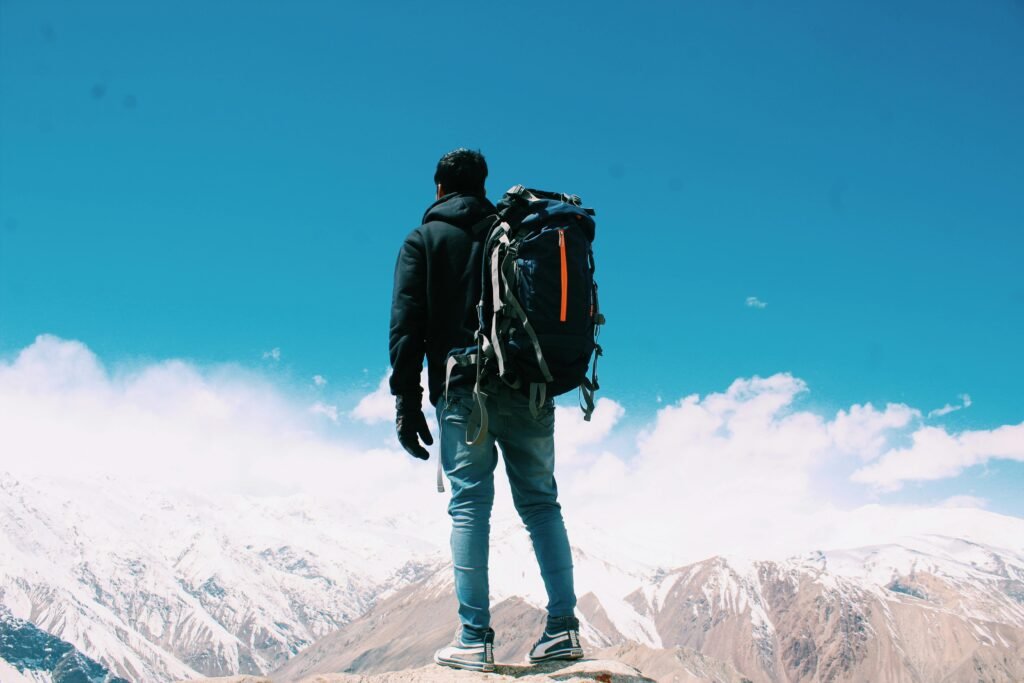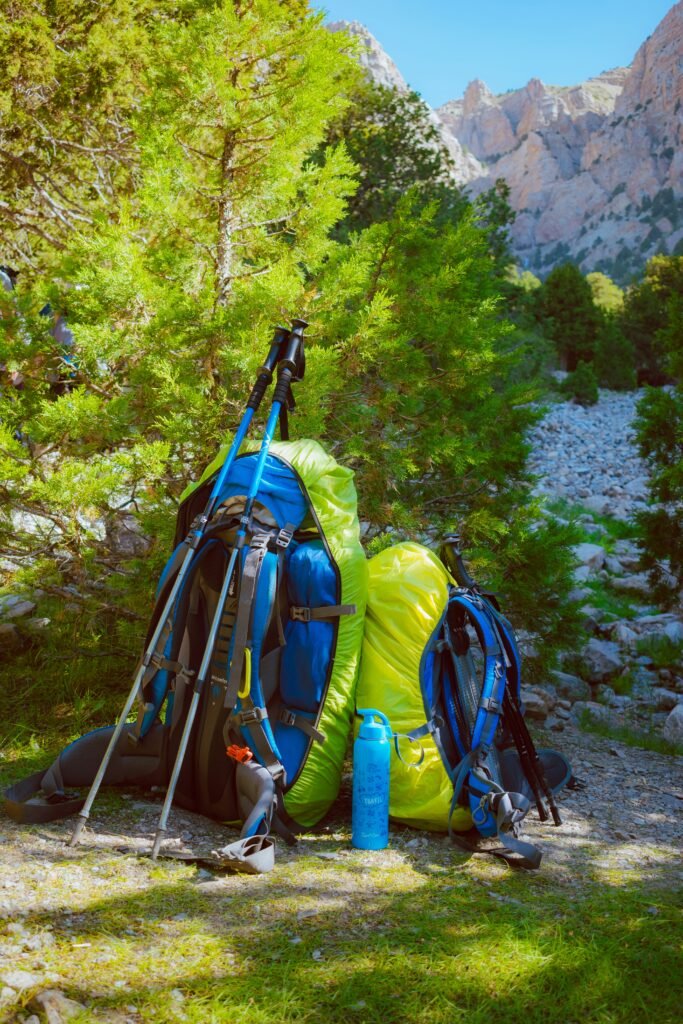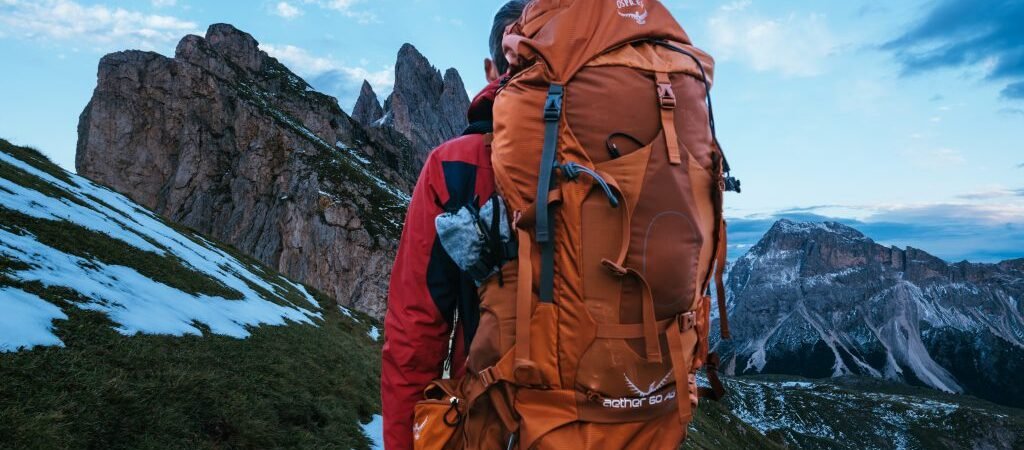Last updated: September 2025
Table of Contents
Introduction
Let’s be honest—nothing kills the experience of a beautiful trail like an uncomfortable backpack digging into your shoulders or flopping around with every step. Whether you’re heading out for a quick two-hour hike or a multi-day backcountry trek, the right backpack makes a huge difference. Trust me.
So as you’re getting your gear together, make sure you select your backpack carefully. And if the task sounds scary (there are a lot of options), I am here to help out!
This comprehensive guide breaks down the best hiking backpacks for 2025, helping you find the perfect fit for your next adventure. From lightweight day hike backpacks to feature-packed trekking backpack options, we’ll walk you through what to look for, what to avoid, and share personal favorites as well as ones trusted by thousands of real hikers.
What you’ll learn in this guide:
- How to properly fit a hiking backpack (most people get this wrong)
- The exact features that matter most for comfort and durability
- Detailed reviews of the top backpacks in each category
- Money-saving tips for choosing the right pack without overspending
*This post may contain affiliate links. If you use them, I may earn a small commission at no extra cost to you.
Why Your Backpack Choice Matters
Your backpack is your base of operations on the trail. It carries your water, food, first aid, extra layers, and maybe even your tent. The wrong one will make your hike a chore. The right one? You’ll barely notice it’s there.
Quick Reality Check: I once took a city-style backpack on a six-hour mountain hike. No hip belt, no ventilation, no sternum strap. I was drenched in sweat and had a sore back for days, not to mention chafing. Never again.
The Hidden Costs of a Bad Backpack
- Injury risk: Poor weight distribution can cause back, shoulder, and neck pain
- Reduced endurance: Uncomfortable packs drain energy faster
- Gear damage: Inadequate protection can ruin expensive equipment
- Safety concerns: Difficulty accessing emergency supplies when you need them most
- Discomfort: Lack of padding, no straps where they should be and other attributes not fit for your hike can keep distracting you from the hike.
How to Measure Your Torso for Proper Fit
Backpacks are similar to clothes in that they need to fit too. Before diving into features, you need to know your torso length. Most hikers skip this crucial step and end up with a pack that doesn’t fit right.
Step-by-Step Measuring Guide
- Find your C7 vertebra: Tilt your head forward and feel for the prominent bone at the base of your neck
- Locate your iliac crest: Place your hands on your hips with thumbs pointing backward—your thumbs should rest on the iliac crest
- Measure the distance: Have someone measure from the C7 vertebra to the imaginary line between your iliac crests
Torso Length Categories
- Extra Small: 13-15 inches
- Small: 15-17 inches
- Medium: 17-19 inches
- Large: 19-21 inches
- Extra Large: 21+ inches
Pro Tip: Many quality backpacks offer adjustable torso lengths, making them suitable for multiple sizes.

Essential Features to Look for in a Hiking Backpack
1. Suspension System (The Foundation of Comfort)
The suspension system is how the pack transfers weight from the bag to your body. Here’s what to prioritize:
Hip Belt
- Should sit on your hip bones, not your waist
- Needs substantial padding for loads over 20 lbs
- Look for pockets for snacks and small items
Shoulder Straps
- Should curve naturally around your shoulders
- Padding should start where the straps meet your shoulders
- Avoid straps that dig into your neck or armpit
Load Lifters
- Small straps that connect the top of the shoulder straps to the pack
- Should angle back at 45 degrees when properly adjusted
- Essential for loads over 25 lbs
Sternum Strap
- Prevents shoulder straps from sliding off
- Should be adjustable vertically and horizontally
- Look for quick-release buckles
2. Back Panel Design
Ventilation Systems
- Mesh panels: Allow airflow but provide less load transfer
- Tensioned mesh: Suspends the pack away from your back
- Channeled padding: Grooves in the foam padding for air circulation
Frame Types
- Internal frame: Better for technical terrain and climbing
- Frameless: Ultralight option for loads under 30 lbs
- External frame: Rare today, but excellent for heavy, bulky loads
3. Access Points
Top Loading vs Panel Loading
- Top loading: Traditional design, simple but can be hard to access items at bottom
- Panel loading: Like a suitcase, easy to organize but potentially less secure
- Hybrid: Best of both worlds with multiple access points
Bottom Compartment
- Sleeping bag compartment keeps clean and dirty gear separated
- Removable divider allows full-length access when needed
4. Hydration Compatibility
Internal Reservoir Sleeve
- Insulated sleeves prevent freezing in winter
- Should have port for hose routing
External Bottle Pockets
- Side mesh pockets should be accessible while wearing pack
- Compression straps prevent bottles from falling out
5. Weather Protection
Water Resistance
- DWR (Durable Water Repellent) coating is standard
- 1000-3000mm waterproof rating for main fabric
Rain Cover
- Built-in covers are convenient but add weight
- Separate covers can be replaced if damaged
- Should cover the entire pack including bottom
Understanding Backpack Capacity and Volume
Choosing the right size is crucial for comfort and functionality. Here’s how to match capacity to your hiking style:
Day Hikes (15-30 Liters)
What you’ll carry:
- Water (2-3 liters)
- Snacks/lunch
- First aid kit
- Extra clothing layer
- Rain jacket
- Phone, maps, headlamp
Recommended capacity:
- Short hikes (2-4 hours): 15-20L
- Full day hikes (6-8 hours): 20-30L
Weekend Trips (30-50 Liters)
Additional gear:
- Sleeping system (bag, pad, pillow)
- Shelter (tent or share of group gear)
- Cooking system
- Extra food and water
- More clothing options
Multi-Day Expeditions (50-80+ Liters)
Extended trip essentials:
- Multiple days of food
- Comprehensive first aid
- Repair kit and tools
- Cold weather gear
- Photography equipment
- Bear canister (in required areas)
Capacity Guidelines by Trip Length:
- 1-2 nights: 40-55L
- 3-5 nights: 55-70L
- Week+: 70-85L
- Expedition/Winter: 85L+
The Goldilocks Principle
Too Small: You’ll struggle to fit everything or have gear hanging off the outside (unsafe and uncomfortable)
Too Large: You’ll fill extra space with unnecessary items, adding weight and bulk
Just Right: Everything fits with a little room for expansion, balanced load distribution

Materials and Construction: What Makes a Durable Backpack
Understanding materials helps you choose a pack that will last through years of adventures.
Fabric Weights and Durability
Denier (D) Rating
- 70D: Ultralight but less durable, good for fair-weather hiking
- 210D: Sweet spot for most hikers—durable yet reasonable weight
- 330D+: Heavy-duty for rough use, expedition conditions
Popular Materials
- Ripstop Nylon: Prevents tears from spreading
- Cordura: Extremely durable but heavier
- Dyneema: Ultralight and strong but expensive
Construction Details That Matter
Seam Construction
- Flat-felled seams: Strongest option, used in stress areas
- Bound seams: Good durability, lighter weight
- Raw seams: Lightest but least durable
Stress Point Reinforcement
- Bartacking: Dense stitching at high-stress points
- Reinforcement patches: Extra fabric where wear occurs
- YKK zippers: Industry standard for reliability
Hardware Quality
- Buckles: Look for name brands like ITW Nexus or Duraflex
- Compression straps: Should be easily adjustable under load
- Zippers: YKK is the gold standard for durability
Best Day Hike Backpacks (15-30L)
1. Osprey Daylite Plus (20L) – Best Overall Day Pack
Price Range: $65-85 Weight: 1 lb 4 oz
Pros:
- Lightweight: Easy to carry even on longer day hikes
- Affordable: Great value for new hikers
- Versatile: Works for both trails and city use
- Modular: Attaches to larger Osprey packs for multi-use setups
- Lifetime warranty: Osprey’s famous “All Mighty Guarantee”
Cons:
- No padded hip belt: Can get uncomfortable with heavier loads
- Limited organization: Not many internal compartments for gear
- Basic suspension: Minimal padding compared to technical packs
Best for: Casual day hikers, urban use, travel, beginners
2. REI Co-op Flash 22 – Best Ultralight Day Pack
Price Range: $49-69 Weight: 14 oz
Pros:
- Super lightweight: Weighs under 1 lb, ideal for fast hikes
- Minimalist but functional: Carries essentials without excess
- Hydration compatible: Includes a sleeve for water reservoirs
- Budget-friendly: One of the best values out there
- Compressible: Packs down small when not in use
Cons:
- Lacks structure: Feels floppy if not fully packed
- Minimal padding: Not the most comfortable for longer treks
- No frame: Poor load transfer with heavy items
Best for: Ultralight enthusiasts, trail running, minimalist hikers
3. Deuter Speed Lite 24 – Best Ventilation
Price Range: $89-109
Weight: 1 lb 6 oz
Pros:
- Excellent ventilation: Airstripes system keeps your back cool
- Ergonomic fit: Designed to stay snug without restricting movement
- Durable: Can handle rough trails without wear
- Active fit: Moves with your body during dynamic activities
- Quality construction: German engineering and materials
Cons:
- Slightly heavier: More weight than minimalist packs
- Fewer pockets: Less external storage for quick-access items
- Price: Costs more than basic day packs
Best for: Warm weather hiking, active hikers, those who run hot
4. Patagonia Nine Trails 28L – Best for Longer Day Hikes
Price Range: $129-149 Weight: 1 lb 10 oz
Pros:
- Spacious main compartment: Easy to load and access gear
- Breathable back panel: Helps reduce sweat buildup
- Durable material: Holds up to wear and tear
- Comfortable suspension: Better weight distribution than basic packs
- Environmental commitment: Made with recycled materials
Cons:
- Pricey for a day pack: Higher cost than similar-sized packs
- Limited exterior gear loops: Not ideal for carrying trekking poles externally
- Overkill for short hikes: Features you may not need for 2-3 hour hikes
Best for: All-day hikes, photographers, those who carry extra gear
5. Gregory Maya 20 (Women’s) / Miwok 24 (Men’s) – Best Comfort
Price Range: $99-119 Weight: 1 lb 8 oz
Pros:
- Dynamic suspension: Moves with your body for comfort
- Well-padded hip belt: Provides solid load transfer for a day pack
- Multiple access points: Top and front panel access
- Gender-specific fit: Tailored to body differences
- Hydration ready: Internal reservoir sleeve and port
Cons:
- Overkill for short hikes: Features may be excessive for short outings
- Slightly bulkier than others: Larger profile for a day pack
- Price point: Costs more than basic options
Best for: All-day adventures, hikers who want trekking pack features in day pack size
Best Weekend Backpacks (30-50L)
1. Osprey Exos 48 (Men’s) / Eja 48 (Women’s) – Best Ultralight Weekend Pack
Price Range: $200-250 Weight: 2 lbs 6 oz
Pros:
- Incredibly lightweight: Impressive weight-to-feature ratio
- Excellent ventilation: Airspeed suspension keeps you cool
- Customizable: Removable features let you cut weight further
- Comfortable: Surprisingly comfy for an ultralight pack
- Great organization: Multiple pockets and attachment points
Cons:
- Price: Premium cost for ultralight features
- Less padding: Not ideal for heavy loads over 35 lbs
- Durability concerns: Lighter materials may show wear faster
Best for: Ultralight backpackers, experienced hikers, warm weather trips
2. REI Co-op Trailbreak 40 – Best Budget Weekend Pack
Price Range: $149-179 Weight: 3 lbs 2 oz
Pros:
- Affordable: Great entry point for multi-day hiking
- Simple design: Easy to use with all necessary features
- Integrated rain cover: Extra protection at no extra cost
- Adjustable torso: Fits range of body sizes
- Solid construction: Good durability for the price
Cons:
- Heavier: More weight than premium packs
- Basic suspension: Adequate but not luxurious
- Limited adjustability: May not fit everyone perfectly
Best for: Beginners, budget-conscious hikers, occasional weekend trips
Best Multi-Day Trekking Backpacks (50-80L+)
1. Osprey Atmos AG 65 (Men’s) / Aura AG 65 (Women’s) – Best Overall Comfort
Price Range: $280-320 Weight: 4 lbs 5 oz
Pros:
- Anti-Gravity suspension: Distributes weight evenly and comfortably
- Excellent organization: Plenty of compartments and access points
- Great ventilation: Mesh back panel prevents overheating
- Durable construction: Built to handle years of use
- Comprehensive feature set: Everything you need for long trips
Cons:
- Expensive: On the higher end of the price spectrum
- Heavy: Weight penalty for all the features and comfort
- Overkill for some: More pack than casual hikers need
Best for: Serious backpackers, long-distance hiking, heavy loads
2. Gregory Baltoro 65 (Men’s) Best for Heavy Loads
Price Range: $300-350 Weight: 4 lbs 12 oz
Pros:
- Superior load hauling: Handles 50+ lbs comfortably
- Custom fit: Adjustable everything for perfect fit
- Weather-ready: Built-in rain cover and rugged construction
- Exceptional organization: Multiple compartments and pockets
- Lifetime warranty: Gregory stands behind their products
Cons:
- Heavyweight: One of the heavier packs in its class
- Premium price: Quality comes at a cost
- Complex: May be overwhelming for beginners
Best for: Expedition hiking, winter camping, photographers with heavy gear
3. Granite Gear Crown 3 60L – Best Ultralight Trekking Pack
Price Range: $199-249
Weight: 2 lbs 10 oz
Pros:
- Remarkably light: Incredible weight savings without sacrificing function
- Versatile design: Roll-top with removable lid options
- Comfortable: Surprising comfort for minimal weight
- Durable: Tough materials despite light weight
- Great value: Premium features at reasonable price
Cons:
- Minimal padding: Not ideal for loads over 40 lbs
- No rain cover included: Must purchase separately
- Less organization: Fewer pockets than traditional packs
Best for: Thru-hikers, ultralight enthusiasts, experienced backpackers
Women-Specific Hiking Backpacks
Women’s backpacks aren’t just smaller men’s packs—they’re designed for different body proportions and needs.
Key Differences in Women’s Packs
Torso Length
- Generally shorter than men’s equivalent sizes
- Different shoulder strap spacing
Hip Belt Design
- Angled to fit wider hip measurements
- Different curve and padding placement
Shoulder Strap Shape
- Curved to accommodate chest differences
- Different attachment points
Load Distribution
- Lower center of gravity considerations
- Different weight distribution patterns
Top Women-Specific Recommendations
Day Hiking: Gregory Maya 20, Osprey Daylite Plus
Weekend Trips: Osprey Eja 48, REI Co-op Trailbreak 40 Women’s
Multi-Day: Osprey Aura AG 65, Gregory Maven 68L, Kelty Coyote 65 Women’s
Budget vs Premium: What’s Worth the Investment
Budget Packs ($50-150)
Pros: Lower financial risk, basic features work fine for occasional use Cons: Heavier, less durable, minimal adjustability, basic materials
Best Budget Picks: REI Co-op Flash 22, Kelty Redwing 44, REI Co-op Trailbreak series
Mid-Range Packs ($150-250)
Pros: Good feature-to-price ratio, decent durability, better comfort Cons: May lack premium materials or advanced features
Best Mid-Range Picks: Deuter Speed Lite series, Gregory day packs, Osprey Exos/Eja
Premium Packs ($250-400+)
Pros: Top materials, maximum comfort, comprehensive features, lifetime warranties Cons: Higher cost, may include features you don’t need
Best Premium Picks: Osprey Atmos/Aura, Gregory Baltoro/Deva, Arc’teryx Bora
What’s Worth Spending More On
- Suspension system: Comfort pays dividends on long hikes
- Durability: Better materials save money long-term
- Warranty: Lifetime warranties provide peace of mind
- Weight savings: Every ounce matters on long trips
Where You Can Save
- Extra pockets: Basic organization often suffices
- Premium materials: Mid-grade fabrics are usually adequate
- Brand names: Some lesser-known brands offer great value
- Latest features: Last year’s model often works just fine
Common Backpack Fitting Mistakes to Avoid
Mistake #1: Focusing Only on Capacity
The Problem: Choosing based on liters alone ignores fit and features The Solution: Start with proper fit, then consider capacity needs
Mistake #2: Not Testing with Weight
The Problem: Empty packs feel completely different than loaded ones The Solution: Use store weights or bring your own gear to test
Mistake #3: Ignoring Gender-Specific Options
The Problem: Assuming unisex packs will fit everyone well The Solution: Try gender-specific models for better fit
Mistake #4: Buying Too Big “Just in Case”
The Problem: Large packs encourage overpacking and poor weight distribution The Solution: Buy for your actual needs, not theoretical maximums
Mistake #5: Skipping Professional Fitting
The Problem: Missing subtle fit issues that cause problems on trail The Solution: Get fitted by experienced staff at outdoor retailers
Also read on: Other hiking mistakes to avoid
Packing Tips for Maximum Comfort
Weight Distribution Principles
Heavy Items (60% of weight)
- Place close to your back
- Keep low in pack for day hikes
- Keep high for multi-day trips
Medium Items (30% of weight)
- Fill spaces around heavy items
- Use for pack structure
Light Items (10% of weight)
- Bottom of pack or outer pockets
- Easy access items on top
The 10% Rule
Your loaded pack should weigh no more than 10% of your body weight for day hikes, 20% for overnight trips.
Pro tip: to save on weight consider DIY Dehydrated Meals for Easy Backpacking & Hiking. Tips & recipes
Compression is Key
- Use compression straps to prevent load shifting
- Pack should feel solid, not loose
- External gear should be minimal and secure
Accessibility Strategy
Top of Pack: Items needed during the day (rain jacket, snacks, first aid) Hip Belt Pockets: Frequently used small items (phone, snacks, lip balm) Side Pockets: Water bottles, maps, trekking poles Bottom Compartment: Items only needed at camp (sleeping bag, camp clothes)
More tips: How to Pack a Backpack

Maintenance and Care
Regular Cleaning
After Each Trip
- Empty all pockets completely
- Shake out debris and dirt
- Wipe down with damp cloth
- Air dry completely before storage
Deep Cleaning (Monthly for Regular Use)
- Hand wash with mild soap
- Use soft brush for stubborn dirt
- Rinse thoroughly
- Air dry only—never use heat
Storage Tips
- Store in cool, dry place
- Don’t compress for long periods
- Check periodically for pest damage
- Keep zippers and buckles lubricated
Repair and Maintenance
Common Issues:
- Zipper problems: Clean and lubricate regularly
- Fabric tears: Repair immediately to prevent spreading
- Buckle failure: Keep spare hardware
- Seam failure: Professional repair recommended
When to Replace:
- Frame damage
- Multiple system failures
- Extensive fabric wear
- Poor fit due to body changes
Frequently Asked Questions
How do I know if my backpack fits correctly?
A properly fitted pack should:
Have 80% of weight on your hips
Allow full range of arm motion
Not dig into shoulders or neck
Feel balanced when you release your hands
Have load lifters angled back at 45 degrees
Can I use a day pack for overnight trips?
Only if you’re experienced with ultralight techniques and the weather is favorable. Most day packs lack the capacity and features needed for safe overnight trips.
What’s the difference between men’s and women’s packs?
Women’s packs typically have:
Shorter torso lengths
Narrower shoulder strap spacing
Curved hip belts for wider hips
Different load distribution design
How much should I spend on my first backpack?
Day pack: $50-100 is sufficient
Weekend pack: $100-200 covers most needs
Multi-day pack: $200-300 for quality that will last
Do I need a pack with lots of pockets?
More pockets help organization but add weight and complexity. Consider your packing style and how much organization you actually use.
What size pack do I need for a week-long trip?
Most week-long trips require 60-70L, but experienced ultralight hikers can manage with 40-50L. Consider your gear volume and packing efficiency.
Are expensive packs worth it?
Premium packs offer better materials, comfort, and warranties. They’re worth it if you hike regularly, carry heavy loads, or prioritize comfort.
How do I break in a new backpack?
Start with short, lightly loaded hikes and gradually increase distance and weight. Adjust fit as you learn the pack’s characteristics.
Can I fly with my hiking backpack?
Yes, but remove or secure all straps, use a protective cover, and be prepared for potential damage. Consider it checked luggage.
What’s the best brand for hiking backpacks?
Top brands include Osprey, Gregory, REI Co-op, Deuter, and Granite Gear. The “best” depends on your specific fit and feature needs.
Conclusion
Choosing the right hiking backpack is one of the most important gear decisions you’ll make. A well-fitted, appropriate pack enhances every aspect of your hiking experience, while a poor choice can turn your dream adventure into an uncomfortable ordeal.
Remember these key takeaways:
- Fit trumps features – The most comfortable pack is the one that fits your body correctly
- Match capacity to actual needs – Bigger isn’t always better
- Invest in quality where it matters – Suspension systems and materials make a difference
- Test before you trek – Always try packs with weight before committing to long trips
- Maintenance matters – Proper care extends pack life significantly
Whether you’re just starting with day hikes or planning your first thru-hike, use this guide as your starting point. Every hiker’s needs are unique, but the principles of fit, function, and quality remain constant.
Ready to find your perfect pack? Start by measuring your torso, determine your capacity needs, and visit a knowledgeable retailer for hands-on testing. Your back (and your hiking experiences) will thank you.
Happy trails!
This guide is updated regularly with the latest pack releases and user feedback. Have questions or suggestions? Let us know in the comments below.

Leave a Reply